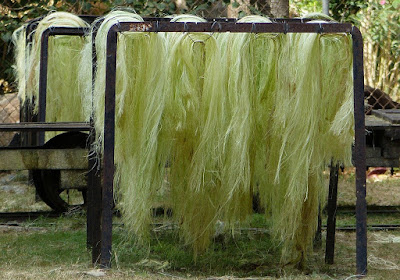Sisal fiber is derived from leaves of plant. It is usually obtained by machine decortications. The strands are usually creamy white, average from 80-120 cm in length and 0.2 – 0.4 mm in diameter and are lustrous in appearance. The World production is about 3000,000 tones, Brazil being the largest producer followed by China, Mexico, Tanzania, Kenya and Madagascar. Sisal is a member of the agave family; Agavae Sisalana is the commercially grown species. The plants grow for 7 to 12 years and then produce a flower stalk 4 to 6 meters tall and die. Sisal is a xerophytic plant and thus it can grow in dry climates but it will not grow sufficiently in poorly drained soil. The life of sisal plant is usually 15-18 years. Sisal is generally harvested once a year but if the soil and the climate permits it can harvested three times in two years.
Gradation of sisal fiber:
Sisal is used and graded by the industries in three grades.
- The lower grade: High content of cellulose and hemicelluloses. Used in paper industry.
- The medium grade: Used in the cordage industry for making: ropes, baler and twine. Ropes and twines used in marine, agricultural, and general industrial use.
- The higher grade: Fiber after treatment is converted into yarns and used by the carpet industry.
Processing of Sisal Fibers:

- The purpose of the early processing is to extract the fibers from the fresh leaves.
- The fresh leaves are harvested from the plants; the workers cut 10mm in length from the tip of the leaf, to avoid any injury from the hard sharp tip.
- Fresh leaves without tip are decorticated then washed (with water), binding is carried out followed by cleaning then drying and again cleaning.
- The leaves are cut at the base, carried to the factory, rolled and the water squeezed out, and the other mushy tissues scraped away from the fibers.
- The fibers are then washed and hung out in the sun. They can be dyed directly.
Features of Sisal fibers:
- In natural fibers, the flaws or weak links are irregularly spaced in the fiber; the strength will depend on the length of the fiber used for the tensile test.
- Sisal fiber tensile strength and percentage elongation decrease with increase in test length and Young’s Modulus and average modulus increase with test length. When speed of testing increases the Young’s Modulus and tensile strength increases.
- Sisal fibers are smooth, straight and yellow in color. Sisal is fairly coarse and inflexible so the sisal fiber can be long or short.
- Sisal is valued for cordage use because of its strength, durability, ability to stretch, affinity for certain dyestuffs, and resistance to deterioration in saltwater.
Physical Properties of Sisal Fibers:
- Length 2.88 mm
- Width 22.6 μm
- Tenacity 57.2 cN/Tex
- Elongation 3.02%
- Moisture regain 13%



